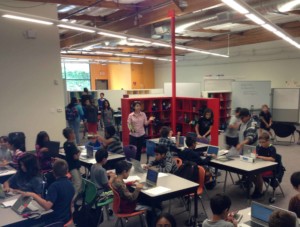Building an Education Innovation Index
Key Points
-
In the United States, schools, districts and universities find it difficult to innovate within an entrenched and well-established system.
-
Innovation continues to be a vital element in the educational ecosystem.
-
What if we reframed the concept of school itself as an education innovation enterprise?

Much has been written about 1) innovation as a key factor in organizational success and 2) the difficulty of innovating in established organizations. While innovation in the corporate world focuses on finding ways to improve profits, the social sector continues to innovate to increase impact. In the United States, schools, districts and universities find it difficult to innovate within an entrenched and well-established system. Given the critical importance of reaching the goal where every young person has the knowledge, skills and dispositions to find professional success and make a difference – and our collective deficits in reaching this goal – innovation continues to be a vital element in the educational ecosystem.
This is not to say that innovation isn’t happening. It is. In the ed tech sector, around new school launches, within school redesign, and in many individual classrooms throughout the world, pockets of innovation exist. $20.8B was invested by Ed Tech venture capital in 2021. But what if we reframed the concept of school itself as an education innovation enterprise? What would be different? Could we measure the level of innovation in any given school – especially as it relates to equity and outcomes?
Innovative solutions sit at the intersection of feasibility, desirability, benefit, and viability. When we think about innovation in schools, reflection around these four areas is helpful. Is the concept viable – meaning, do we have the time, resources, etc. to build an innovative solution? Is the solution desirable – do users (teachers, parents, students) actually want it? Is it beneficial – meaning will it increase outcomes for learners? Will it increase equity in education? Finally, is it feasible – do we have the knowledge and skill to design and implement?
So what does this look like in education? At the federal level, funding exists to promote innovation in education through the EIR grant program, with $180M projected for 2021. As a comparison, DARPA is funded at $3.5B for 2021. Various states have also implemented innovation-supporting agendas. Idaho’s Mastery Education Network awards small grants to districts around mastery-based learning, Colorado’s Innovation Schools, and Virginia’s Innovation Network connect and support innovative school districts and initiatives. Districts, especially larger districts, build innovation teams (ex. Boston Public School Innovation Department), hire Chief Innovation Officers to promote and support prototyping around best-practices within the classroom and/or new school models (Dallas ISD Personalized Learning). Regional networks supported by common agreements such as the Real-world Learning Initiative in Kansas City create scaled and common innovation initiatives.
Innovative solutions sit at the intersection of feasibility, desirability, benefit, and viability.
Nate McClennen
Fundamentally, successful innovation will be supported by leadership but implemented and developed from the ground up. Community ownership, clear project plan(s), leadership, impact evaluation, and resource allocation all play a role in a successful innovation project.
Given the importance of innovation in any sector, consistent metrics exist in corporate, higher education (US News, Reuters), and global contexts. However, limited efforts have occurred to measure innovation writ large in educational ecosystems. In 2015, Bellwether Education evaluated district-wide innovation in a select group of cities in an attempt to build an innovation index. The OECD report on education innovation in 2021 looked at innovation globally at the national level, but also received critique around methodology and approach. Finally, various organizations have built databases of schools based on criteria for innovation such as Getting Smart’s Schools Worth Visiting, the Canopy Project (started by Christensen Institute and now jointly run by Transcend and CRPE (who recently joined ASU Mary Lou Fulton Teachers College), Education Reimagined’s map of learner-centered environments, and Australia’s Annual Innovative Schools Award.
If a true innovation index existed for schools and could be matched with student outcome data, each school or district could place itself on a path towards increased innovation for equity. There are pitfalls. Is the field of learning sciences advanced enough to establish critical innovative practices that are known to improve equitable outcomes through a variety of lenses? It will take a concerted effort to build an effective and useful tool to support school innovation.
Given these potential pitfalls, an innovation index could consider the following dimensions. We describe each dimension and propose a measurement system to collect data to build the index within the dimensions. A rubric-based self-assessment effort based on the elements of each dimension could be designed to evaluate around the index or it may manifest as a simple binary checklist with articulated evidence criteria.
CONTEXT DIMENSION
Mission and leadership. All innovation initiatives are grounded in a strong, clearly-defined and research based learning model. Schools that focus in this way learn and improve faster and increase collaboration among staff who are all moving in the same direction.
- The learning model is written into the mission and vision for the school or district.
- School board members participate in professional learning around learning sciences and support school and district efforts to reach the vision.
- Innovation initiatives lead with the learner at the center. As a model, Turnaround for Children’s Building Blocks clearly articulates the foundational elements necessary for innovative redesign efforts.
- Evaluation of innovation initiatives is clearly defined, updated and public.
LEARNING MODEL DIMENSION
Culture. An innovation mindset must exist within an organization in order for advancement towards common goals. High level social-emotional skills contribute to a strong innovation culture. The ability to collaborate, relate, reflect, and learn from others builds a strong school culture and increases the probability of success on any innovation agenda.
- State level data on culture and climate.
- Evaluation surveys from all community members.
Learning goals and integration. Every learning ecosystem should have a clear set of goals for students that articulate the critical skills needed to address emerging challenges. To measure this, we would consider rubrics across the following elements:
- The existence, visibility, quality, and clarity of a portrait of a graduate/profile of a learner.
- Evidence of a robust and comprehensive learning outcome/competency progression tied to the portrait of a graduate.
- Clear integration of the competency progression in the curriculum, instruction, and assessment approaches.
Technology enhanced. While technology should not drive the learning model, when used effectively, can enhance and support learning model implementation and resultant learning experiences.
- Core technology stack understood by all including LMS that supports the learning model.
- Blended learning strategy.
- Use of virtual and augmented reality.
- Technology to store comprehensive learner records.
- All learners, educators, and other staff have access to a connected device both at school and outside of school.
Pedagogy. An innovative learning organization will need to have evidence of specific approaches to best support learner success based on the future skillsets required by adults to thrive.
- Evidence of high quality project-based learning.
- Real-world connections (place-based, experiential) and pathways (at the high school level) to connect directly to possible careers and bundled skills.
- Implementation of personalized learning approaches, especially around core skills such as math and literacy, to ensure that every learner is highly literate in language and mathematics.
- Learners have appropriate opportunities to co-design with their teacher to build relevant learning experiences.
Assessment. Assessing learner progress with authentic approaches allows for clear instructional and curricular choices to allow every student to reach their potential.
- Individualized growth metrics are used for every student in all measurable content areas.
- Progress on learning goals is monitored in real-time and available to teachers/students/families as needed.
- A clear articulation of proficiency on learner goals is defined organization wide.
- Learner records are accessible between schools and across age cohorts to show visibility of growth in various dimensions.
Advisory. Strong advisory programs support learner-centered environments where every learner feels supported by a caring adult.
- Advisory occurs weekly with progress monitoring, goal setting, coaching, peer support, skill building
- In older age cohorts, college/career education and advising is part of every learner’s schedule.
- High quality student support systems wrap around all learners – including support for mental health, physical health, financial health, etc.
SCHOOL MODEL DIMENSION
Professional Learning. Personalized professional learning systems should mirror the student experience. Every teacher should be on a personal path with clear outcomes to improve their craft.
- An onboarding program exists, is practiced and directly connected to the organizational learning model. Every educator new to the system has a clear onboarding path with milestones and support systems to ensure accelerated learning of the model.
- Professional learning systems are clearly defined in relationship to the learning model and the individual educator.
- Educators apply the principles of project management through professional learning systems.
Staffing and Compensation Models. Staffing models that isolate educators and compensation models linked only to experience are detrimental to learners. Innovation initiatives should be grounded in collaborative teams, focused on how to professionalize the profession, and compensating educators for learning and growth in service of multiple dimensions of learner outcomes.
- Educators work in teams.
- Educators have defined leadership roles and opportunities that extend beyond administrative promotion.
- Educator compensation is (partly) based on documented professional learning growth.
- Educator teams have clearly defined roles around assessment, curriculum and instruction with some specialization available to support long-term teacher growth and sustainability.
Scheduling. Modifying schedules and timetables to better support learners can support most innovation initiatives.
- The weekly schedule incorporates larger blocks of time, flexible personalized time and adequate weekly team planning time for educators. The schedule reflects the intent and goals of the organization.
- The annual calendar intentionally supports the school community.
Facilities and Transportation. Recognizing that facilities and transportation are constrained by funding, solutions in this element can be scaled dependent on resources. Most districts cannot just build a new facility, but if they can, reconsidering what school infrastructure looks like is imperative. If not, rethinking space use, furniture arrangement, etc. can complement other areas of an innovation agenda.
- The facility design and use matches the needs of the learning model.
- The facility is linked to the community using accessible modes of transportation.
Funding Model. Although this element is controlled typically at the state and federal levels, education systems need to continue to evaluate the equity and control within funding models. More local flexibility in spending and equitable distribution of resources increases the probability of success for innovation initiatives.
- Financial model supports supplemental funds for all students to participate in unique learning experiences outside of the school week and/or year.
- Financial model supports local control over best targeted spending.
Dimensions and elements related to sustainability are also critical and need to be included. The Green Schools National Network has made great progress in this arena already.
Given that each of these dimensions and elements is important, mapping change over time, viewing individual dimension data and comparing to larger datasets could be an effective way to innovate for equity for all learners. If a learning organization made its data public, collaboration and sharing around best practices may increase across the country.
An Innovation Index, used as an internal improvement tool, could accelerate the redesign process across the nation. Early steps include 1) building a coalition of participating schools, 2) designing shared agreements around the index, dimensions and elements, 3) designing connected tools to collect data, 4) create a central data repository and mapping system, and 5) map a long-term plan to understand the impact of the Innovation Index project.
While not an easy lift, the creation of a K-12 National Innovation Index is an important step to discuss and debate as we collectively build new learning models where every learner gains the knowledge, skills, and agency to both contribute to and thrive within the world.
The New Pathways (#NewPathways) campaign will serve as a road map to the new architecture for American schools, whThe New Pathways (#NewPathways) campaign will serve as a road map to the new architecture for American schools, where every learner, regardless of zip code, is on a pathway to productive and sustainable citizenship, high wage employment, economic mobility, and a purpose-driven life. It will also explore and guide leaders on the big education advances of this decade–how access is expanded and personalized, and how new capabilities are captured and communicated. When well implemented, these advances will unlock opportunities for all and narrow the equity gap. You can engage with this ongoing campaign using #NewPathways or submit an idea to Editor using the writing submission form.






0 Comments
Leave a Comment
Your email address will not be published. All fields are required.